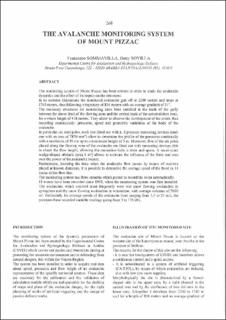| dc.description.abstract | The monitoring system of Mount Pizzac has been created in order to study the avalanche dynamics and the effect of its impact on the structures. In its extreme dimensions the monitored avalanche gets off at 2200 meters and stops at 1745 meters, thus following a trajectory of 836 meters with an average gradient of 310. The necessary structures for monitoring have been installed in the track of the gully between the above limit of the flowing zone and the central track of the accumulation zone, for a whole length of 418 meters. They allow to observe the development of the event, thus recording continuously: pressures, speed and geometric variations of the body of the avalanche. In particular six steel poles, each one fitted out with n. 8 pressure measuring devices (each one with an area of 7850 mm") allow to determine the profile of the pressures continually with a resolution of 50 em up to a maximum height of 5 m. Moreover, five of the six poles placed along the flowing zone of the avalanche are fitted out with measuring devices able to check the flow height, allowing the recreation both in time and space. A small-sized wedge-shaped obstacle (area 1 m-) allows to estimate the influence of the form and area over the power of the avalanche impact. Furthermore, knowing the time when the avalanche flow passes by means of sections placed at known distances, it is possible to determine the average speed of the front in 14 tracks of the flow line. The monitoring system has three cameras which permit to record the event automatically. 15 events have been recorded since 1993, when the monitoring system was first installed. The avalanches which occured most frequently were wet snow flowing avalanches in springtime and dry snow flowing avalanches in wintertime, with average volumes of 2000 m", Particularly for average speeds of the avalanche front ranging from 2.5 to 23 m/s, the pressures have recorded variable readings going from 5 to 175 kPa. | en_US |
